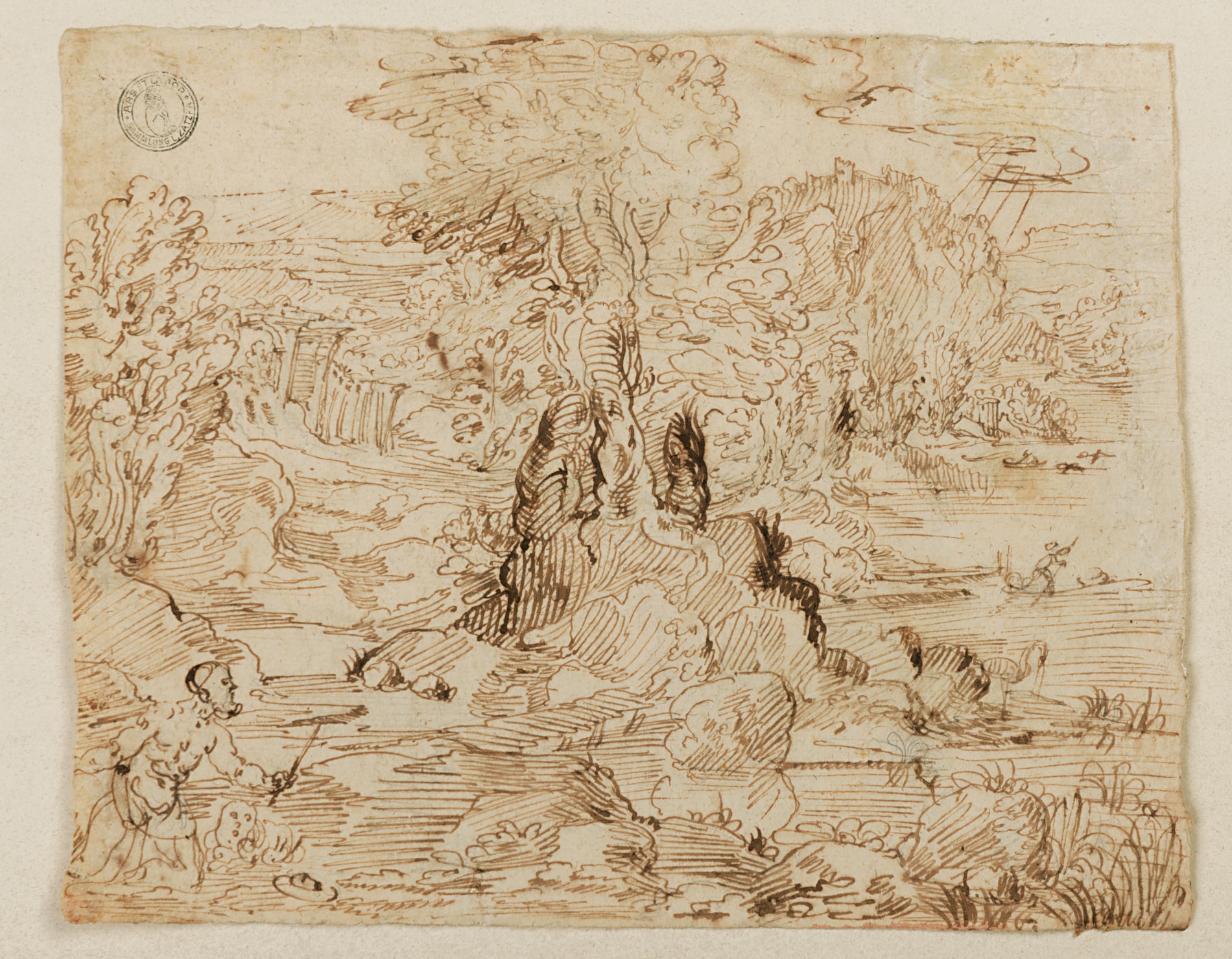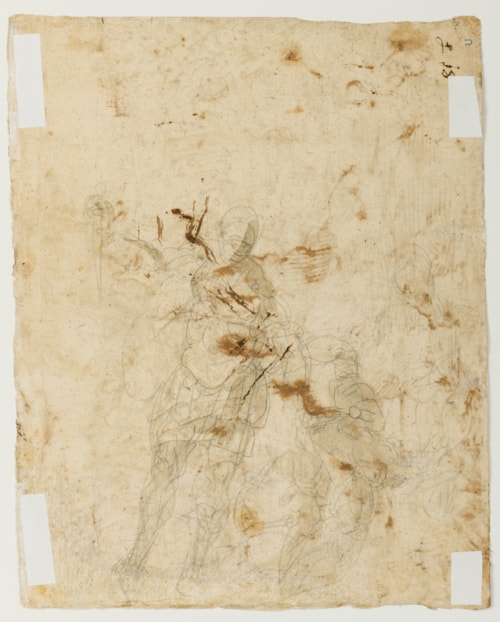Lodewijk TOEPUT, called POZZOSERRATO
(Mechelen c.1550 - Treviso 1603/5)
Landscape with the Penitent Saint Jerome
Sold
Pen and brown ink, over traces of an underdrawing in black chalk.
A sketch of a soldier holding a dagger above a cowering figure (for a Massacre of the Innocents?) drawn in black chalk on the verso.
Numbered L.18 on the verso.
210 x 265 mm. (8 1/4 x 10 3/8 in.)
A sketch of a soldier holding a dagger above a cowering figure (for a Massacre of the Innocents?) drawn in black chalk on the verso.
Numbered L.18 on the verso.
210 x 265 mm. (8 1/4 x 10 3/8 in.)
The recto of the present sheet is a fine and typical example of Pozzoserrato’s imaginary pen landscapes. As Teréz Gerszi has written of the artist, ‘Toeput varied his manner in the landscape drawings according to their different purposes, [and] these sheets reveal the individual mark of the artist far more than his figure studies. His landscapes and townscapes known thus far, over fifty in number, bear witness to a wide-ranging interest in natural and manmade subjects, including mountains, forests, riversides, rocky scenes, and gardens of Veneto villas.’ Among stylistically comparable drawings by Pozzoserrato is a Landscape with a Falconer in the Musée Bonnat-Helleu in Bayonne and a Landscape with a Hercules and the Ox-Driver in the Hermitage in St. Petersburg; the latter was reproduced in an engraving by Jan Sadeler I.
While the black chalk sketch rapidly drawn on the verso of this sheet cannot be definitively related to any extant painting by Pozzoserrato, it may perhaps be a first idea for the figure of Saint Michael in his altarpiece of Saint Michael Archangel Defeating the Devil, in the church of San Leonardo in Treviso.
This drawing was at one time part of a large group of mainly landscape studies - including numerous sheets by Pozzoserrato - owned by the Viennese architect and collector Ludwig Zatzka (1857-1925). Zatzka began his collecting in 1885, and eventually assembled around two thousand drawings. According to Frits Lugt, Zatka’s collection was based on a nucleus of landscape drawings by Pozzoserrato assembled in the 18th century by a certain Count Gianazei in Udine and acquired by Zatzka around 1900. These drawings, which include the present sheet, were almost all studies of imaginary landscapes, none of which appear to have been translated into paintings. A group of eight landscape drawings by Pozzoserrato with the same Gianazei-Zatzka provenance, many of which are stylistically similar to the present sheet, was in an American private collection and appeared at auction in London in 1971. Drawings by Pozzoserrato with a Zatka provenance are today in the collections of the University of Michigan Museum of Art in Ann Arbor, the Fondation Custodia (Lugt Collection) in Paris, the Albertina in Vienna, and elsewhere.
While the black chalk sketch rapidly drawn on the verso of this sheet cannot be definitively related to any extant painting by Pozzoserrato, it may perhaps be a first idea for the figure of Saint Michael in his altarpiece of Saint Michael Archangel Defeating the Devil, in the church of San Leonardo in Treviso.
This drawing was at one time part of a large group of mainly landscape studies - including numerous sheets by Pozzoserrato - owned by the Viennese architect and collector Ludwig Zatzka (1857-1925). Zatzka began his collecting in 1885, and eventually assembled around two thousand drawings. According to Frits Lugt, Zatka’s collection was based on a nucleus of landscape drawings by Pozzoserrato assembled in the 18th century by a certain Count Gianazei in Udine and acquired by Zatzka around 1900. These drawings, which include the present sheet, were almost all studies of imaginary landscapes, none of which appear to have been translated into paintings. A group of eight landscape drawings by Pozzoserrato with the same Gianazei-Zatzka provenance, many of which are stylistically similar to the present sheet, was in an American private collection and appeared at auction in London in 1971. Drawings by Pozzoserrato with a Zatka provenance are today in the collections of the University of Michigan Museum of Art in Ann Arbor, the Fondation Custodia (Lugt Collection) in Paris, the Albertina in Vienna, and elsewhere.
Almost nothing is known of Lodewijk Toeput’s career before his arrival in Venice in the early 1570s, although he may have trained with Hans Bol in his native city of Mechelen and with Marten de Vos in Antwerp. Almost all of his career was spent working in Italy, where he was known as Pozzoserrato (a literal Italian translation of his Dutch surname, which means ‘closed well’). He spent several years in Venice where, according to the 17th century biographer Carlo Ridolfi, he worked in the studio of Tintoretto, painting the landscape backgrounds in the master’s canvases. (Interestingly, he is also recorded in 1576 as a gioielliere, or jeweler, on the Rialto.) He also visited Rome in 1578 and 1581, and may also have spent some time in Florence. Highly regarded in particular for his imaginary landscapes - Ridolfi described the artist as ‘eccelente ne’paesi’ - Pozzoserrato worked as a fresco painter in various villas and palaces of the Veneto, his paintings combining a Flemish interest in nature with the spirited brushwork of his Venetian contemporaries. (An example of his work of this type are the frescoes of the Seasons in the Villa Chiericati-Mugna in Logna di Schiavon, near Vicenza.) Ridolfi also noted of the artist that ‘He delighted in painting distant objects, pleasing the eye with the haziness of the air strewn with orange and vermilion clouds, with the burgeoning dawn, the rising sun, and sometimes rain, whirlwinds and storms.’
In 1582 Pozzoserrato left Venice to settle in Treviso, some 27 kilometres north of the city, becoming a citizen of the town in 1585 and remaining there until his death. He provided altarpieces and paintings for churches in and around Treviso, such as for the Capella dei Rettori in the church of the Monte di Pietà, and also produced a number of easel pictures. Establishing a stylistic chronology for Pozzoserrato’s oeuvre has been made more difficult by the fact that only a relatively few extant works by the artist are dated.
As an artist, Pozzoserrato was arguably more original, and more distinctive, in his drawings than in his paintings or frescoes. Around fifty landscape drawings by him are known, the earliest known of which is dated 1573, together with a much smaller number of figure studies. Difficult to date with any accuracy, the artist’s drawings are almost always in pen and ink, and display a preference for landscape or townscape subjects, perhaps reflecting his Flemish origins. This was, however, tempered with such characteristic elements of Venetian draughtsmanship as a freedom in the handling of wash and a bold, spirited penwork. Pozzoserrato executed a number of panoramic views of towns and cities, and was also fond of landscape drawings which incorporated elegant genre scenes of the Venetian nobility at leisure in the elaborate gardens and villas of the terraferma.
In 1582 Pozzoserrato left Venice to settle in Treviso, some 27 kilometres north of the city, becoming a citizen of the town in 1585 and remaining there until his death. He provided altarpieces and paintings for churches in and around Treviso, such as for the Capella dei Rettori in the church of the Monte di Pietà, and also produced a number of easel pictures. Establishing a stylistic chronology for Pozzoserrato’s oeuvre has been made more difficult by the fact that only a relatively few extant works by the artist are dated.
As an artist, Pozzoserrato was arguably more original, and more distinctive, in his drawings than in his paintings or frescoes. Around fifty landscape drawings by him are known, the earliest known of which is dated 1573, together with a much smaller number of figure studies. Difficult to date with any accuracy, the artist’s drawings are almost always in pen and ink, and display a preference for landscape or townscape subjects, perhaps reflecting his Flemish origins. This was, however, tempered with such characteristic elements of Venetian draughtsmanship as a freedom in the handling of wash and a bold, spirited penwork. Pozzoserrato executed a number of panoramic views of towns and cities, and was also fond of landscape drawings which incorporated elegant genre scenes of the Venetian nobility at leisure in the elaborate gardens and villas of the terraferma.
Provenance
Probably Count Gianazei, Udine
Ludwig Zatzka, Vienna (Lugt 2672)
Possibly Gustav Nebehay, Vienna
Anonymous sale, London, Christie’s, 23 March 1982, lot 19
Annamaria Edelstein (Succi Ltd.), London, in 1991
Wolfgang Ratjen, Munich
The Stiftung Ratjen, Vaduz, Liechtenstein, in 1992
Galerie Artesepia, Paris, in 2014
Jacques and Colette Ulmann, Nogent-sur-Marne (Lugt 3533)
Thence by descent.
Ludwig Zatzka, Vienna (Lugt 2672)
Possibly Gustav Nebehay, Vienna
Anonymous sale, London, Christie’s, 23 March 1982, lot 19
Annamaria Edelstein (Succi Ltd.), London, in 1991
Wolfgang Ratjen, Munich
The Stiftung Ratjen, Vaduz, Liechtenstein, in 1992
Galerie Artesepia, Paris, in 2014
Jacques and Colette Ulmann, Nogent-sur-Marne (Lugt 3533)
Thence by descent.
Literature
Teréz Gerszi, ‘The Draughtsmanship of Lodewijk Toeput’, Master Drawings, Winter 1992, p.369; Mario di Giampaolo, ed., Disegno italiano antico: Artisti e opere dal Quattrocento al Settecento, Milan, 1994, illustrated p.216.






